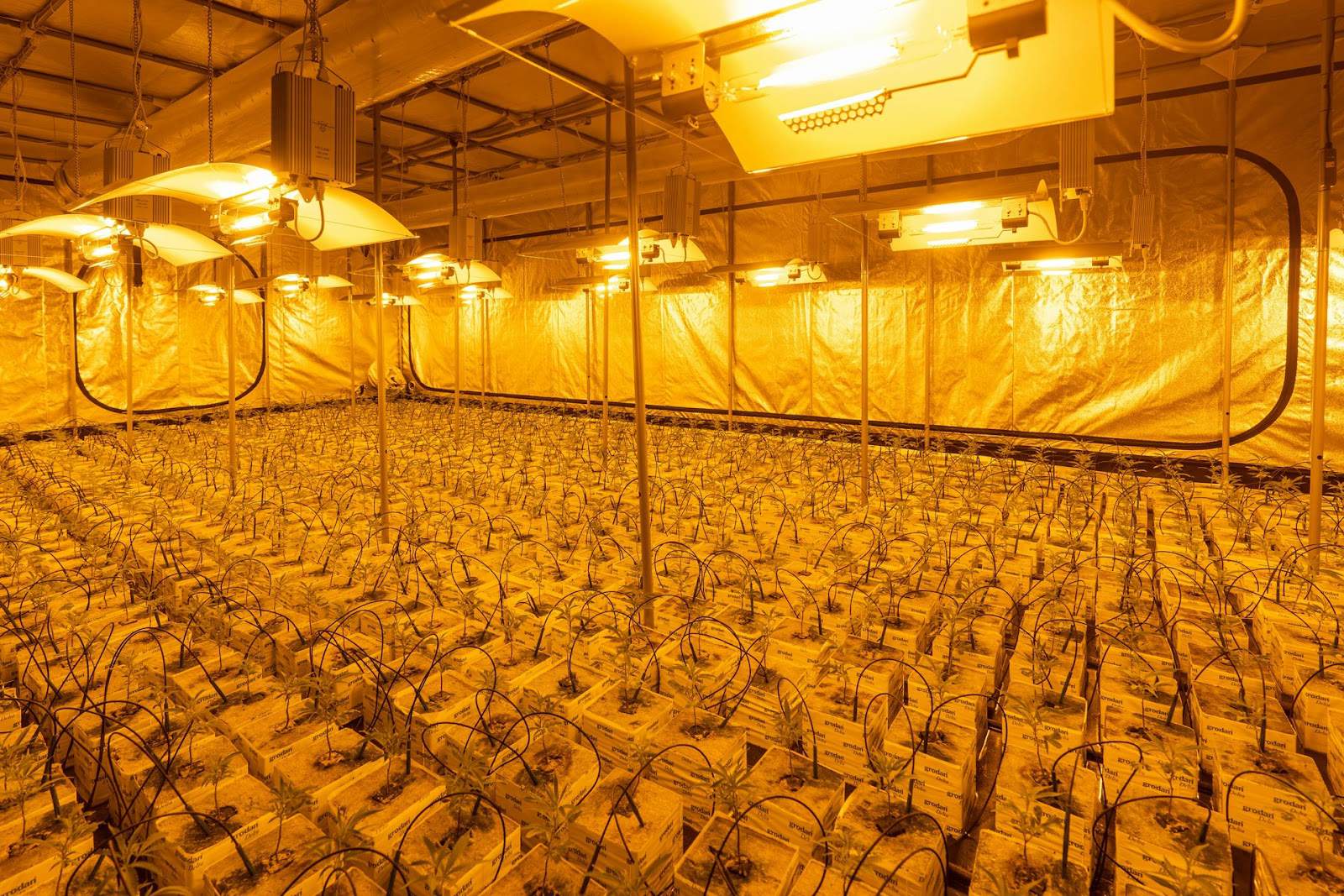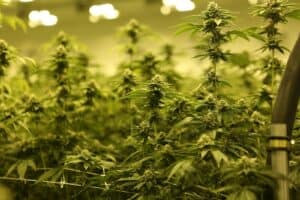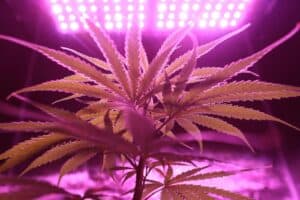The light cycle is the most critical aspect in the growth of a healthy and productive cannabis plant. For beginners or professional indoor growers, understanding how light cycles affect the growth stage in the plants would make a difference in terms of yield.
Key Takeaways
- The cannabis light cycle determines the vegetative as well as the flowering phases of the plant.
- Use of the light schedules would benefit indoor growers for enhanced growth in cannabis.
- Different growth stages require different light characteristics to grow perfectly.
What is the cannabis light cycle, and why is it important?

The cannabis light cycle refers to the light-dark schedule a plant undergoes in twenty-four hours. The seedling production will result in the flowering or budding phases of growth for this plant if directly affected.
What does the effect of the light cycle mean on the cannabis plant’s growth?
- Seedling stage: This is the period of approximately 18-24 hours of light exposure per day in order to facilitate good root growth. This stage is crucial because it determines future development.
- Vegetative Stage: It thrives under 18 hours of light and 6 hours of darkness per day. At this stage, cannabis plants tend to grow well vegetatively. During this stage, cannabis plants grow sturdy stems and leaves.
- Flowering Stage: This process will start after placing a seedling under a cycle of 12 hours of light and 12 hours of darkness, which is simply a natural way to simulate fall conditions. And while the marijuana plant is likely to spend a good deal of that period energizing buds.
Why is a lighting schedule important in indoor growing?
You will be able to control the light schedule as an indoor grower, thus elongating or shortening growth stages for maximum yield potential. You will be able to grow cannabis throughout the year without experiencing any seasonality, therefore, you will have healthier plants and better harvests since you can fine-tune the light spectrum for every stage of your cannabis plant. Proper light scheduling will keep your plants productive and avoid stress and hermaphroditism.
What’s the Best Light Cycle for Each Growth Stage?
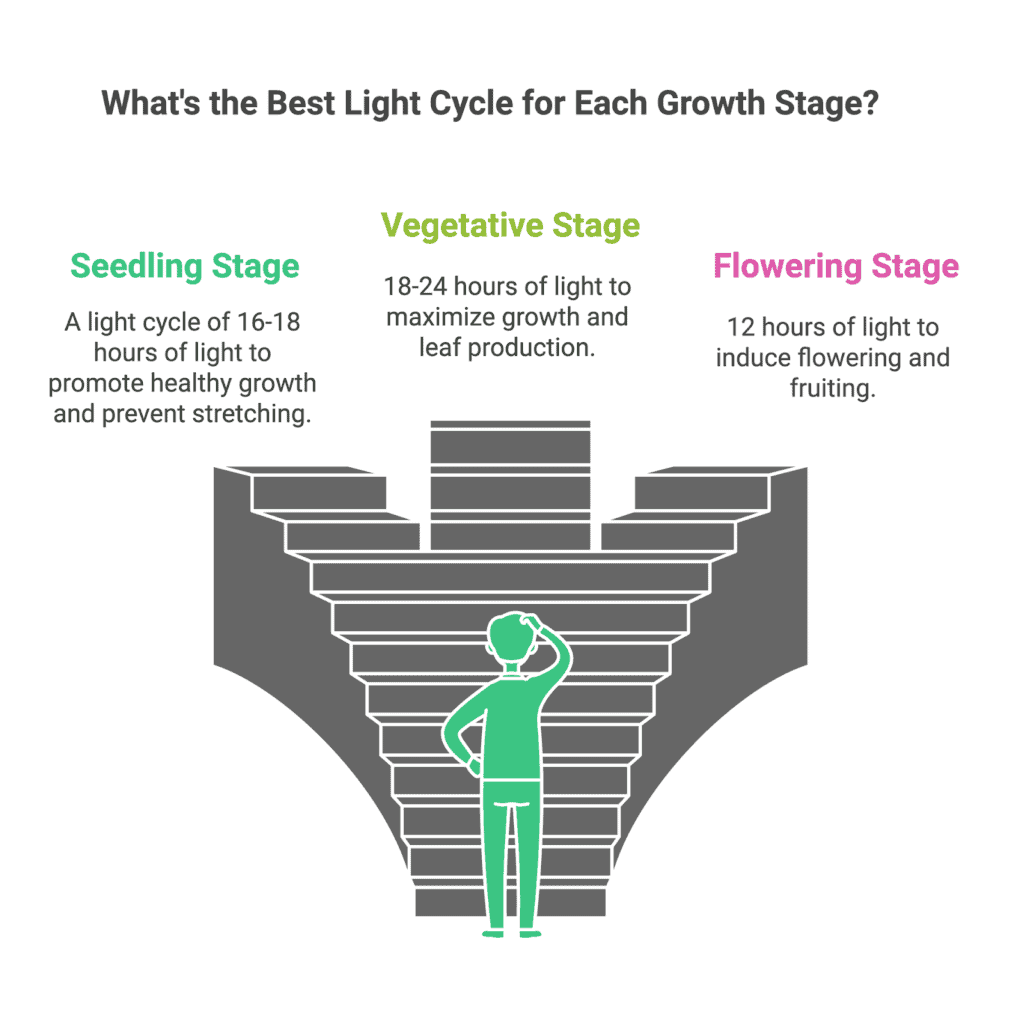
The light cycle will change with the growth stage for cannabis to grow well.
Ideal Schedule for the Vegetative Cycle
In this stage, plants require longer lighting periods to promote growth.
- Light Cycle: 18 hours of light and 6 hours of darkness per day.
- Goal: Promote rapid shoot, leaf, and root development.
- Optimal Light: Use LED lighting with a full light spectrum to mimic natural sunlight.
This stage focuses on structural growth, preparing the plant for the next phase.
How to Manage Light for the Flowering Stage?
Switching to a flowering schedule is critical for cannabis plants to produce buds.
- Light Cycle: 12 hours of light and 12 hours of uninterrupted darkness.
- Goal: Signal the plant to start flowering and develop high-quality buds.
- Cannabis Flowering Tips: Prevent light leaks during the dark period to prevent stress and low yields. Constant light and darkness are required for the best flowering.
What About the Seedling Stage?
Seedlings need light for photosynthesis but less intense than when the plant is mature.
- Light Cycle: 18-24 hours of light per day.
- Light Quantity: Utilize a low-powered grow light so that the young plants will not get scorched.
- Schedule Tip: Gradually shift to the light schedule of the vegetative stage as seedlings grow to allow them to acclimate to the increased light demands.
How Can You Improve Lighting for Indoor Cannabis Production?
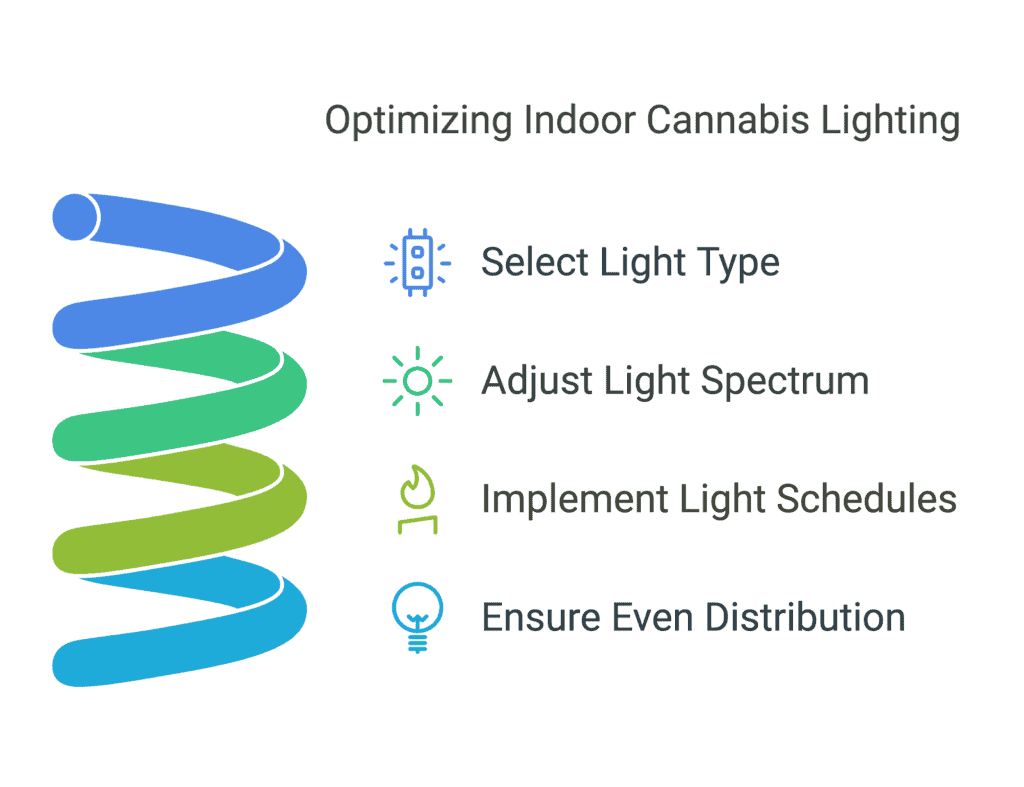
Optimizing a grow light configuration ensures the plants get the optimal conditions at each growth stage for cannabis plants.
What’s the Role of Light Spectrum?
Different spectrum of light influence cannabis plant development.
- Blue Light (400-500 nm): Induces vegetative growth
- Red Light (600-700 nm): Induces flowering.
- Full Spectrum LED Lighting: It offers a balanced mix of wavelengths for all growth stages.
LED lighting saves energy and emits less heat, this makes them ideal for indoor grows. Plus, with adjustable spectrums in lights, you can choose exactly the one your plant needs at every stage.
How to Pick the Right Grow Light?
The following factors help in picking the right grow lights:
- Power: Select lights with sufficient wattage for your grow area. The size of your grow space determines the amount of light needed.
- Adjustability: Opt for lights that allow spectrum and intensity adjustments. This flexibility ensures the right conditions for different stages.
- Energy Efficiency: LEDs are cost-effective and long-lasting. They reduce operational costs compared to traditional lights.
Creating an optimal lighting environment reduces energy costs and boosts cannabis yields.
What Problems Do Indoor Growers Experience with Light Cycles?

Even though light cycles can be controlled accurately indoors, there could be some problems.
What is the Effect of Too Much or Too Little Light?
- Too Much Light: It causes leaf burn and increases heat stress. Too much bright light can burn the tissues of plants.
- Too Little Light: This leads to slow growth and weak plants. Low light impairs photosynthesis and energy generation.
The amount of light per day should be balanced for the consistent growth of cannabis. Overexposure can be avoided by ensuring proper spacing between lights and plants.
How to Handle Light Leaks?
Light leaks during the dark period of the flowering stage can stress the plant, delay or prevent flowering, and reduce overall yield.
Seal your grow area completely to maintain a strict 12-hour dark cycle. Proper sealing ensures that external light sources do not interfere with the flowering process.
What’s the Impact of Incorrect Light Schedules?
An improper schedule can:
- Cause hermaphroditism, leading to seed production.
- Reduce the potency and quality of buds. Stressed plants often produce lower-quality harvests.
Automated timers are a great tool to ensure a consistent light cycle. These devices help maintain accuracy without constant monitoring.
Conclusion
Mastering the light cycle of the cannabis plant can help indoor growers get the maximum out of the potential of the plant. Learn about the part of light cycles in different stages of growth, maximize your grow lights, and work with common issues to achieve complete success in cultivating cannabis. Right knowledge and appropriate tools will keep you growing strong, high-yielding cannabis throughout the year, paying attention to the intensity and spectrum of the light and for how long at every stage.
Frequently Asked Questions
How many light hours a day does vegetative growth require?
18 hours of light with 6 hours of darkness a day is suggested for vegetative growth.
What’s the ideal light cycle for flowering marijuana?
Flowering marijuana plants require a tight light schedule with 12 hours of light to 12 hours of dark every day to make buds form.
Can I grow marijuana with regular lights?
Although seedlings may be grown under standard lights, grow lights of all kinds offer a better spectrum and intensity at any given stage.

